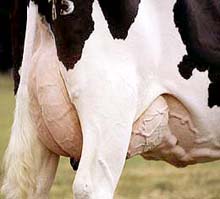Breeding mastitis out of the dairy herd

New technology developed by CSIRO Livestock Industries (CLI) will lead to the development of new strategies designed to substantially reduce the $140 million lost each year due to Australian dairy cows contracting udder infections.
Developed with support from the Innovative Dairy Products Cooperative Research Centre (Dairy CRC), the bovine immune gene microarray provides researchers with the means to rapidly assess the gene activity profiles of infected and mastitis-resistant cattle.
“Mastitis is an infection of the mammary (udder) tissue caused by a range of bacteria,” says CLI’s research team leader, Dr Ross Tellam.
“In dairy cattle this disease results in reduced milk production and altered milk quality and costs Australian dairy farmers between $120 and $150 per cow to treat.
“Identifying the genes responsible for resistance or susceptibility to mastitis opens up the possibility of selecting and breeding dairy cattle with an increased natural resistance to the disease,” Dr Tellam says.
According to the Dairy CRC’s Chief Executive Officer, Dr Paul Donnelly, it is desirable that the industry develops approaches to managing mastitis which reduce the dependence on antibiotics.
“Reducing the incidence of mastitis through improved genetics will lessen costs to individual farmers and improve animal welfare,” Dr Donnelly says.
The research is part of the Dairy CRC’s Gene Discovery Program which aims to identify, isolate and determine the function of specific dairy cow genes.
More information:
Ross Tellam, 07 3214 2476, mobile: 0409 775 044CSIRO Livestock Industries
For information on the Dairy CRC visit: www.dairycrc.com
Media assistance:
Veronica Toohey, 07 3214 2960, mobile: 0408 096 723
CSIRO Livestock Industries
Gabrielle Sheehan, 03 9607 8608, 0409 945 001
Dairy CRC
Media Contact
More Information:
http://www.csiro.au/index.asp?type=mediaRelease&id=PrmastitisAll latest news from the category: Agricultural and Forestry Science
Newest articles

Eruption of mega-magnetic star lights up nearby galaxy
Thanks to ESA satellites, an international team including UNIGE researchers has detected a giant eruption coming from a magnetar, an extremely magnetic neutron star. While ESA’s satellite INTEGRAL was observing…

Solving the riddle of the sphingolipids in coronary artery disease
Weill Cornell Medicine investigators have uncovered a way to unleash in blood vessels the protective effects of a type of fat-related molecule known as a sphingolipid, suggesting a promising new…

Rocks with the oldest evidence yet of Earth’s magnetic field
The 3.7 billion-year-old rocks may extend the magnetic field’s age by 200 million years. Geologists at MIT and Oxford University have uncovered ancient rocks in Greenland that bear the oldest…





















